A Review of Digital Era Governance Research in the First Two Decades: A Bibliometric Study
Abstract
:1. Introduction
2. Literature Review
3. Materials and Methods
4. Results
4.1. Descriptive Overview
4.2. Scientific Production
4.3. Network Analysis
4.4. Thematic Evolution Analysis
4.5. Dynamic Changes in Terms’ Importance
5. Discussion
5.1. The Evolution of DEG Research
5.2. The Relevance of DEG Research
5.3. Limitations
6. Conclusions
Author Contributions
Funding
Data Availability Statement
Acknowledgments
Conflicts of Interest
Appendix A
| Research Hotspots | Keywords |
|---|---|
| Open government | open government, open data, transparency, open government data, social media, e-participation, e-democracy, accountability, citizen participation, collaboration, participation, democracy |
| Government and ICT | government, internet, governance, public administration, e-commerce, citizens, information systems, communication technologies, innovation |
| E-governance | e-governance, ICT, public sector, cloud computing, smart city, big data, smart government |
| E-government | e-government, local government, digital divide, e-services, usability, public services |
| Adoption in developing countries | adoption, developing countries, India, corruption, Jordan |
| Trust and security | trust, security, e-government services, privacy |
| Evaluation and implementation | evaluation, case study, implementation, public value |
| Interoperability | interoperability, ontology, framework |
References
- Dunleavy, P.; Margetts, H.; Bastow, S.; Tinkler, J. New public management is dead—Long live digital-era governance. J. Public Adm. Res. Theory 2006, 16, 467–494. [Google Scholar] [CrossRef] [Green Version]
- Dunleavy, P.; Margetts, H.; Tinkler, J.; Bastow, S. Digital Era Governance: IT Corporations, the State, and E-Government; Oxford University Press: UK, Oxford, 2006. [Google Scholar] [CrossRef]
- Margetts, H.; Dunleavy, P. The second wave of digital-era governance: A quasi-paradigm for government on the Web. Philos. Trans. R. Soc. A 2013, 371, 20120382. [Google Scholar] [CrossRef] [PubMed] [Green Version]
- Wojciech, B. Digital Era Governance—A new chapter of public management theory and practice. Maz. Stud. Reg. 2017, 22, 117–129. [Google Scholar] [CrossRef]
- Fang, Z. E-government in digital era: Concept, practice, and development. Int. J. Comput. Appl. Technol. 2002, 10, 1–22. [Google Scholar]
- Janowski, T. Digital government evolution: From transformation to contextualization. Gov. Inf. Q. 2015, 32, 221–236. [Google Scholar] [CrossRef]
- Heeks, R. Understanding e-governance for development. iGovernment Work. Pap. 2001, 11. [Google Scholar] [CrossRef]
- Milakovich, M.E. Digital Governance: New Technologies for Improving Public Service and Participation; Routledge: UK, London, 2012. [Google Scholar] [CrossRef]
- European Commission. Exploring Digital Government transformation in the EU—Analysis of the State of the Art and Review of Literature; European Commission: Luxembourg, 2020. [Google Scholar] [CrossRef]
- Bannister, F.; Connolly, R. Defining e-governance. e-Serv. J. 2012, 8, 3–25. [Google Scholar] [CrossRef]
- Gabryelczyk, R. Has COVID-19 Accelerated Digital Transformation? Initial Lessons Learned for Public Administrations. Inf. Syst. Manag. 2020, 37, 303–309. [Google Scholar] [CrossRef]
- Rossel, P.; Finger, M. Conceptualizing e-governance. In Proceedings of the 1st International Conference on Theory and Practice of Electronic Governance, Macao, China, 10–13 December 2007; ACM Digital Library: New York, NY, USA, 2007; pp. 399–407. [Google Scholar] [CrossRef]
- Larsson, H.; Grönlund, Å. Future-oriented eGovernance: The sustainability concept in eGov research, and ways forward. Gov. Inf. Q. 2014, 31, 137–149. [Google Scholar] [CrossRef]
- Okot-Uma, R.W.O.; London, C.S. Electronic Governance: Re-Inventing Good Governance; Commonwealth Secretariat: London, UK, 2000. [Google Scholar]
- Holmes, D. eGov: eBusiness Strategies for Government; Nicholas Brealey Publishing: New York, NY, USA, 2001. [Google Scholar]
- Backus, M. E-Governance and Developing Countries, Introduction and Examples; International Institute for Communication and Development (IICD): Hague, The Netherlands, 2001. [Google Scholar]
- Bindu, N.; Sankar, C.P.; Kumar, K.S. From conventional governance to e-democracy: Tracing the evolution of e-governance research trends using network analysis tools. Gov. Inf. Q. 2019, 36, 385–399. [Google Scholar] [CrossRef]
- Gil-García, J.R.; Pardo, T.A. E-government success factors: Mapping practical tools to theoretical foundations. Gov. Inf. Q. 2005, 22, 187–216. [Google Scholar] [CrossRef]
- Chan, H.S.; Chow, K.W. Public management policy and practice in western China: Metapolicy, tacit knowledge, and implications for management innovation transfer. Am. Rev. Public Adm. 2007, 37, 479–498. [Google Scholar] [CrossRef]
- United Nations. E-Government Survey 2020: Digital Government in the Decade of Action for Sustainable Development; United Nations: New York, NY, USA, 2020. [Google Scholar]
- Heeks, R.; Bailur, S. Analyzing e-government research: Perspectives, philosophies, theories, methods, and practice. Gov. Inf. Q. 2007, 24, 243–265. [Google Scholar] [CrossRef]
- Alcaide-Muñoz, L.; Bolívar, M.P.R. Understanding e-government research: A perspective from the information and library science field of knowledge. Internet Res. 2015, 25, 633–673. [Google Scholar] [CrossRef]
- Mergel, I.; Edelmann, N.; Haug, N. Defining digital transformation: Results from expert interviews. Gov. Inf. Q. 2019, 36, 101385. [Google Scholar] [CrossRef]
- Vogel, R. What happened to the public organization? A bibliometric analysis of public administration and organization studies. Am. Rev. Public Adm. 2014, 44, 383–408. [Google Scholar] [CrossRef]
- Alcaide-Muñoz, L.; Rodríguez-Bolívar, M.P.; Cobo, M.J.; Herrera-Viedma, E. Analysing the scientific evolution of e-Government using a science mapping approach. Gov. Inf. Q. 2017, 34, 545–555. [Google Scholar] [CrossRef]
- Dwivedi, Y.K. An analysis of e-government research published in transforming government: People, process and policy (TGPPP). Transform. Gov. People Process Policy 2009, 3, 7–15. [Google Scholar] [CrossRef]
- Joseph, R.C. A structured analysis of e-government studies: Trends and opportunities. Gov. Inf. Q. 2013, 30, 435–440. [Google Scholar] [CrossRef]
- Dias, G.P. Fifteen years of e-government research in Ibero-America: A bibliometric analysis. Gov. Inf. Q. 2019, 36, 400–411. [Google Scholar] [CrossRef]
- Cheng, S.; Ding, L. A quantitative study on the research fronts of electronic government. In Proceedings of the 2012 Fifth International Conference on Business Intelligence and Financial Engineering, Lanzhou, China, 18–21 August 2012; pp. 481–485. [Google Scholar]
- de Oliveira Almeida, G.; Zouain, D.M.; Mahecha, Y.L.R. The Status of E-Government Research: A Bibliometric Study. Bus. Manag. Rev. 2014, 3, 7–22. [Google Scholar]
- Ismayilova, N. A Bibliometric Analysis of e-Government Research. 2014, pp. 93–95. Available online: https://ict.az/uploads/konfrans/GOOGLE_SCHOLAR_e-gov/28N.Ismayilova.pdf (accessed on 18 April 2022).
- Rodríguez Bolívar, M.P.; Alcaide Muñoz, L.; López Hernández, A.M. Scientometric study of the progress and development of e-government research during the period 2000–2012. Inf. Technol. Dev. 2016, 22, 36–74. [Google Scholar] [CrossRef]
- Lobonț, O.R.; Țăran, A.M.; Costea, F. E-Government Research Still Matter? A Bibliometric Analysis. Ann. Univ. Dunarea Jos Galati Fascicle I Econ. Appl. Inform. 2020, 26, 58–63. [Google Scholar] [CrossRef]
- Erman, N.; Todorovski, L. Analyzing the structure of the EGOV conference community. In International Conference on Electronic Government; Springer: Berlin, Germany, 2010; pp. 73–84. [Google Scholar]
- Przeybilovicz, E.; Cunha, M.A.; Coelho, T.R. The Development of Studies on Electronic Government in Brazil: A Bibliometric and Sociometric Study. Available online: https://aisel.aisnet.org/cgi/viewcontent.cgi?article=1025&context=confirm2014 (accessed on 18 April 2022).
- Dias, G.P. Bibliometric Analysis of Portuguese Research in e-government. Procedia Technol. 2014, 16, 279–287. [Google Scholar] [CrossRef] [Green Version]
- Dias, G.P. A decade of Portuguese research in e-government: Evolution, current standing, and ways forward. Electron. Gov. Int. J. 2016, 12, 201–222. [Google Scholar] [CrossRef]
- Ajibade, P.; Mutula, S.M. Bibliometric Analysis of Citation Trends and Publications on E-government in Southern African Countries: A Human-computer Interactions and IT Alignment Debate. Libr. Philos. Pract. 2019, 2234, 1–19. [Google Scholar]
- Falagas, M.E.; Pitsouni, E.I.; Malietzis, G.A.; Pappas, G. Comparison of PubMed, Scopus, web of science, and Google scholar: Strengths and weaknesses. FASEB J. 2008, 22, 338–342. [Google Scholar] [CrossRef]
- Mongeon, P.; Paul-Hus, A. The journal coverage of Web of Science and Scopus: A comparative analysis. Scientometrics 2016, 106, 213–228. [Google Scholar] [CrossRef]
- Dwivedi, Y.K.; Singh, M.; Williams, M.D. Developing a demographic profile of scholarly community contributing to the Electronic Government, An International Journal. Electron. Gov. Int. J. 2011, 8, 259–270. [Google Scholar] [CrossRef]
- Aria, M.; Cuccurullo, C. bibliometrix: An R-tool for comprehensive science mapping analysis. J. Informetr. 2017, 11, 959–975. [Google Scholar] [CrossRef]
- Muñoz, J.A.M.; Viedma, E.H.; Espejo, A.L.S.; Cobo, M.J. Software tools for conducting bibliometric analysis in science: An up-to-date review. Prof. Inf. 2020, 29, e290103. [Google Scholar] [CrossRef] [Green Version]
- McKinney, W. Python for Data Analysis: Data Wrangling with Pandas, NumPy, and IPython; O’Reilly Media, Inc.: Sebastopol, CA, USA, 2012. [Google Scholar]
- Hunter, J.D. Matplotlib: A 2D graphics environment. Comput. Sci. Eng. 2007, 9, 90–95. [Google Scholar] [CrossRef]
- Van Eck, N.J.; Waltman, L. Software survey: VOSviewer, a computer program for bibliometric mapping. Scientometrics 2010, 84, 523–538. [Google Scholar] [CrossRef] [PubMed] [Green Version]
- Batagelj, V.; Mrvar, A. Pajek-program for large network analysis. Connections 1998, 21, 47–57. [Google Scholar]
- Wright, M.N.; Ziegler, A. Ranger: A fast implementation of random forests for high dimensional data in C++ and R. J. Stat. Softw. 2017, 77, 1–17. [Google Scholar] [CrossRef] [Green Version]
- Breiman, L. Random forests. Mach. Learn. 2001, 45, 5–32. [Google Scholar] [CrossRef] [Green Version]
- Meyer, D.; Hornik, K.; Feinerer, I. Text mining infrastructure in R. J. Stat. Softw. 2008, 25, 1–54. [Google Scholar] [CrossRef] [Green Version]
- Rinker, T. Textstem: Tools for Stemming and Lemmatizing Text. CRAN Package for R. 2018. Available online: https://cran.r-project.org/web/packages/textstem/ (accessed on 1 August 2021).
- Patience, G.S.; Patience, C.A.; Blais, B.; Bertrand, F. Citation analysis of scientific categories. Heliyon 2017, 3, e00300. [Google Scholar] [CrossRef]
- Rodrigues, R.R. Downside up: Science matters equally to the Global South. Commun. Earth Environ. 2001, 2, 100. [Google Scholar] [CrossRef]
- Criado, J.I.; Gil-Garcia, J.R. Creating public value through smart technologies and strategies: From digital services to artificial intelligence and beyond. Int. J. Public Sect. Manag. 2019, 32, 438–450. [Google Scholar] [CrossRef] [Green Version]
- Layne, K.; Lee, J. Developing fully functional E-government: A four stage model. Gov. Inf. Q. 2001, 18, 122–136. [Google Scholar] [CrossRef]
- Bertot, J.C.; Jaeger, P.T.; Grimes, J.M. Using ICTs to create a culture of transparency: E-government and social media as openness and anti-corruption tools for societies. Gov. Inf. Q. 2010, 27, 264–271. [Google Scholar] [CrossRef]
- Janssen, M.; Charalabidis, Y.; Zuiderwijk, A. Benefits, adoption barriers and myths of open data and open government. Inf. Syst. Manag. 2012, 29, 258–268. [Google Scholar] [CrossRef] [Green Version]
- Meijer, A.; Bolívar, M.P.R. Governing the smart city: A review of the literature on smart urban governance. Int. Rev. Adm. Sci. 2016, 82, 392–408. [Google Scholar] [CrossRef]
- Harzing, A.W.; Van der Wal, R. A Google Scholar h-index for journals: An alternative metric to measure journal impact in economics and business. J. Am. Soc. Inf. Sci. Technol. 2009, 60, 41–46. [Google Scholar] [CrossRef]
- Corrales-Garay, D.; Ortiz-de-Urbina-Criado, M.; Mora-Valentín, E.M. Knowledge areas, themes and future research on open data: A co-word analysis. Gov. Inf. Q. 2019, 36, 77–87. [Google Scholar] [CrossRef]
- Twizeyimana, J.D.; Andersson, A. The public value of E-Government—A literature review. Gov. Inf. Q. 2019, 36, 167–178. [Google Scholar] [CrossRef]
- Janowski, T.; Pardo, T.A.; Davies, J. Government information networks-mapping electronic governance cases through public administration concepts. Gov. Inf. Q. 2012, 29, S1–S10. [Google Scholar] [CrossRef]
- Hirsch, J.E. Does the h index have predictive power? Proc. Natl. Acad. Sci. USA 2007, 104, 19193–19198. [Google Scholar] [CrossRef] [Green Version]
- Wang, C.; Lim, M.K.; Zhao, L.; Tseng, M.L.; Chien, C.F.; Lev, B. The evolution of Omega-The International Journal of Management Science over the past 40 years: A bibliometric overview. Omega 2020, 93, 102098. [Google Scholar] [CrossRef]
- Chen, Y.C.; Gant, J. Transforming local e-government services: The use of application service providers. Gov. Inf. Q. 2001, 18, 343–355. [Google Scholar] [CrossRef]
- Doty, P.; Erdelez, S. Information micro-practices in Texas rural courts: Methods and issues for e-government. Gov. Inf. Q. 2002, 19, 369–387. [Google Scholar] [CrossRef]
- Moon, M.J. The evolution of e-government among municipalities: Rhetoric or reality? Public Adm. Rev. 2002, 62, 424–433. [Google Scholar] [CrossRef]
- Edmiston, K.D. State and local e-government: Prospects and challenges. Am. Rev. Public Adm. 2003, 33, 20–45. [Google Scholar] [CrossRef]
- Reddick, C.G. A two-stage model of e-government growth: Theories and empirical evidence for US cities. Gov. Inf. Q. 2004, 21, 51–64. [Google Scholar] [CrossRef]
- Reddick, C.G. Citizen interaction with e-government: From the streets to servers? Gov. Inf. Q. 2005, 22, 38–57. [Google Scholar] [CrossRef]
- Jaeger, P.T. Deliberative democracy and the conceptual foundations of electronic government. Gov. Inf. Q. 2005, 22, 702–719. [Google Scholar] [CrossRef]
- Gil-Garcia, J.R.; Martinez-Moyano, I.J. Understanding the evolution of e-government: The influence of systems of rules on public sector dynamics. Gov. Inf. Q. 2007, 24, 266–290. [Google Scholar] [CrossRef]
- Helbig, N.; Gil-García, J.R.; Ferro, E. Understanding the complexity of electronic government: Implications from the digital divide literature. Gov. Inf. Q. 2009, 26, 89–97. [Google Scholar] [CrossRef] [Green Version]
- Verdegem, P.; Verleye, G. User-centered E-Government in practice: A comprehensive model for measuring user satisfaction. Gov. Inf. Q. 2009, 26, 487–497. [Google Scholar] [CrossRef]
- Gauld, R.; Goldfinch, S.; Horsburgh, S. Do they want it? Do they use it? The ‘Demand-Side’of e-Government in Australia and New Zealand. Gov. Inf. Q. 2010, 27, 177–186. [Google Scholar] [CrossRef]
- Karunasena, K.; Deng, H. Critical factors for evaluating the public value of e-government in Sri Lanka. Gov. Inf. Q. 2012, 29, 76–84. [Google Scholar] [CrossRef]
- Reddick, C.G.; Turner, M. Channel choice and public service delivery in Canada: Comparing e-government to traditional service delivery. Gov. Inf. Q. 2012, 29, 1–11. [Google Scholar] [CrossRef]
- Estevez, E.; Janowski, T. Electronic Governance for Sustainable Development—Conceptual framework and state of research. Gov. Inf. Q. 2013, 30, S94–S109. [Google Scholar] [CrossRef]
- Janssen, M.; Estevez, E. Lean government and platform-based governance—Doing more with less. Gov. Inf. Q. 2013, 30, S1–S8. [Google Scholar] [CrossRef]
- Klievink, B.; Bharosa, N.; Tan, Y.H. The collaborative realization of public values and business goals: Governance and infrastructure of public–private information platforms. Gov. Inf. Q. 2016, 33, 67–79. [Google Scholar] [CrossRef] [Green Version]
- Brown, A.; Fishenden, J.; Thompson, M.; Venters, W. Appraising the impact and role of platform models and Government as a Platform (GaaP) in UK Government public service reform: Towards a Platform Assessment Framework (PAF). Gov. Inf. Q. 2017, 34, 167–182. [Google Scholar] [CrossRef] [Green Version]
- Matheus, R.; Janssen, M.; Maheshwari, D. Data science empowering the public: Data-driven dashboards for transparent and accountable decision-making in smart cities. Gov. Inf. Q. 2018, 37, 101284. [Google Scholar] [CrossRef]
- Lindgren, I.; Madsen, C.Ø.; Hofmann, S.; Melin, U. Close encounters of the digital kind: A research agenda for the digitalization of public services. Gov. Inf. Q. 2019, 36, 427–436. [Google Scholar] [CrossRef]
- Thompson, N.; Mullins, A.; Chongsutakawewong, T. Does high e-government adoption assure stronger security? Results from a cross-country analysis of Australia and Thailand. Gov. Inf. Q. 2020, 37, 101408. [Google Scholar] [CrossRef]
- Ismagilova, E.; Hughes, L.; Dwivedi, Y.K.; Raman, K.R. Smart cities: Advances in research—An information systems perspective. Int. J. Inf. Manag. 2019, 47, 88–100. [Google Scholar] [CrossRef]
- Zhang, W.; Wang, M.; Zhu, Y.C. Does government information release really matter in regulating contagion-evolution of negative emotion during public emergencies? From the perspective of cognitive big data analytics. Int. J. Inf. Manag. 2020, 50, 498–514. [Google Scholar] [CrossRef]
- Chen, C.; Song, I.Y.; Yuan, X.; Zhang, J. The thematic and citation landscape of data and knowledge engineering (1985–2007). Data Knowl. Eng. 2008, 67, 234–259. [Google Scholar] [CrossRef] [Green Version]
- Callon, M.; Courtial, J.P.; Laville, F. Co-word analysis as a tool for describing the network of interactions between basic and technological research: The case of polymer chemsitry. Scientometrics 1991, 22, 155–205. [Google Scholar] [CrossRef]
- Yu, Y.; Jin, Z.; Qiu, J. Global Isotopic Hydrograph Separation Research History and Trends: A Text Mining and Bibliometric Analysis Study. Water 2021, 13, 2529. [Google Scholar] [CrossRef]
- Cobo, M.J.; López-Herrera, A.G.; Herrera-Viedma, E.; Herrera, F. An approach for detecting, quantifying, and visualizing the evolution of a research field: A practical application to the fuzzy sets theory field. J. Informetr. 2011, 5, 146–166. [Google Scholar] [CrossRef]
- Majdalawi, Y.K.; Almarabeh, T.; Mohammad, H.; Quteshate, W. E-government strategy and plans in Jordan. J. Softw. Eng. Appl. 2015, 8, 211–223. [Google Scholar] [CrossRef] [Green Version]
- Lnenicka, M.; Nikiforova, A. Transparency-by-design: What is the role of open data portals? Telemat. Inform. 2021, 61, 101605. [Google Scholar] [CrossRef]
- Machado, V.; Mantini, G.; Viterbo, J.; Bernardini, F.; Barcellos, R. An instrument for evaluating open data portals: A case study in brazilian cities. In Proceedings of the 19th Annual International Conference on Digital Government Research: Governance in the Data Age; Association for Computing Machinery: New York, NY, USA, 2018; pp. 1–10. [Google Scholar] [CrossRef]
- Hogan, M.; Ojo, A.; Harney, O.; Ruijer, E.; Meijer, A.; Andriessen, J.; Pardijs, M.; Boscolo, P.; Palmisano, E.; Satta, M.; et al. Governance, transparency and the collaborative design of open data collaboration platforms: Understanding barriers, options, and needs. In Government 3.0–Next Generation Government Technology Infrastructure and Services; Springer Cham: New York, NY, USA, 2017; pp. 299–332. [Google Scholar]
- Martinčić-Ipšić, S.; Miličić, T.; Todorovski, L. The influence of feature representation of text on the performance of document classification. Appl. Sci. 2019, 9, 743. [Google Scholar] [CrossRef] [Green Version]
- Salton, G.; Buckley, C. Term-weighting approaches in automatic text retrieval. Inf. Process. Manag. 1988, 24, 513–523. [Google Scholar] [CrossRef] [Green Version]
- Urbanovics, A.; Sasvári, P. The Status of e-Government Research from a Bibliometric Aspect. In Central and Eastern European e|Dem and e|Gov Days 2021: Conference Proceedings; Austrian Computer Society: Wien, Austria, 2021; pp. 75–88. [Google Scholar] [CrossRef]
- Rhee, S.K.; Rha, J.Y. Public service quality and customer satisfaction: Exploring the attributes of service quality in the public sector. Serv. Ind. J. 2009, 29, 1491–1512. [Google Scholar] [CrossRef]
- Lykidis, I.; Drosatos, G.; Rantos, K. The Use of Blockchain Technology in e-Government Services. Computers 2021, 10, 168. [Google Scholar] [CrossRef]
- Wimmer, M.A.; Pereira, G.V.; Ronzhyn, A.; Spitzer, V. Transforming Government by Leveraging Disruptive Technologies: Identification of Research and Training Needs. JeDEM 2020, 12, 87–114. [Google Scholar] [CrossRef]
- Sørensen, E.; Torfing, J. Accountable Government through Collaborative Governance? Adm. Sci. 2021, 11, 127. [Google Scholar] [CrossRef]
- Gacitúa, R.; Astudillo, H.; Hitpass, B.; Osorio-Sanabria, M.; Taramasco, C. Recent Models for Collaborative E-Government Processes: A Survey. IEEE Access 2021, 9, 19602–19618. [Google Scholar] [CrossRef]
- Aristovnik, A.; Kovač, P.; Murko, E.; Ravšelj, D.; Umek, L.; Bohatá, M.; Hirsch, B.; Schäfer, F.-S.; Tomaževič, N. The Use of ICT by Local General Administrative Authorities during COVID-19 for a Sustainable Future: Comparing Five European Countries. Sustainability 2021, 13, 11765. [Google Scholar] [CrossRef]
- Joshi, P.R.; Islam, S.; Islam, S. A Framework for Cloud Based E-Government from the Perspective of Developing Countries. Future Internet 2017, 9, 80. [Google Scholar] [CrossRef] [Green Version]
- Onan, A.; Korukoğlu, S.; Bulut, H. A hybrid ensemble pruning approach based on consensus clustering and multi-objective evolutionary algorithm for sentiment classification. Inf. Process. Manag. 2017, 53, 814–833. [Google Scholar] [CrossRef]
- Sachs, J.D.; Schmidt-Traub, G.; Mazzucato, M.; Messner, D.; Nakicenovic, N.; Rockström, J. Six transformations to achieve the sustainable development goals. Nat. Sustain. 2019, 2, 805–814. [Google Scholar] [CrossRef]
- Wallace, H.; Pollack, M.A.; Roederer-Rynning, C.; Young, A.R. Policymaking in the European Union, 8th ed.; Oxford University Press: Oxford, UK, 2020; p. 471. [Google Scholar]
- Vázquez-López, A.; Marey-Perez, M. Factors Affecting e-Government Adoption by Dairy Farmers: A Case Study in the North-West of Spain. Future Internet 2021, 13, 206. [Google Scholar] [CrossRef]
- Yang, Y. Towards a New Digital Era: Observing Local E-Government Services Adoption in a Chinese Municipality. Future Internet 2017, 9, 53. [Google Scholar] [CrossRef] [Green Version]
- Durkiewicz, J.; Janowski, T. Is Digital Government Advancing Sustainable Governance? A Study of OECD/EU Countries. Sustainability 2021, 13, 13603. [Google Scholar] [CrossRef]
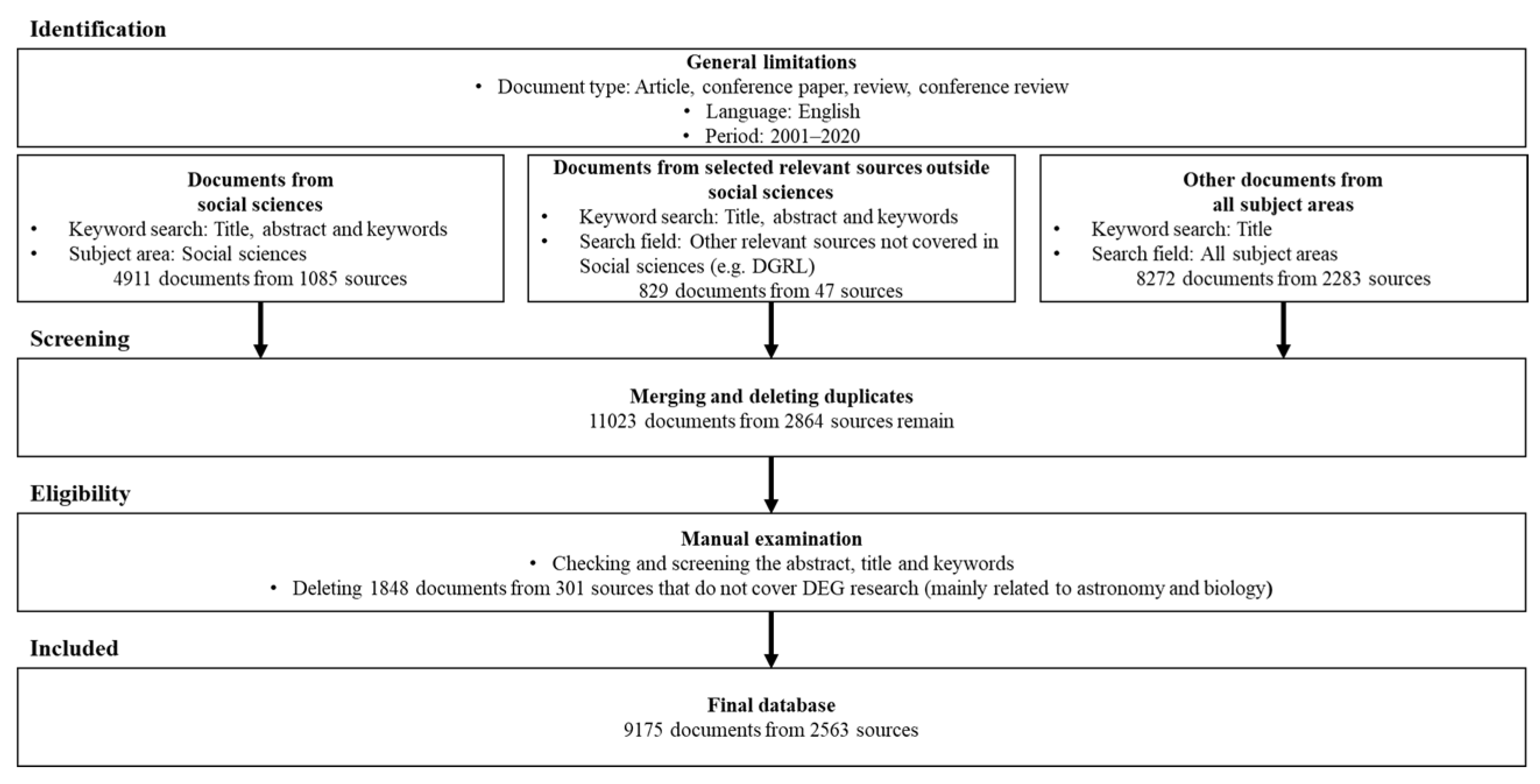
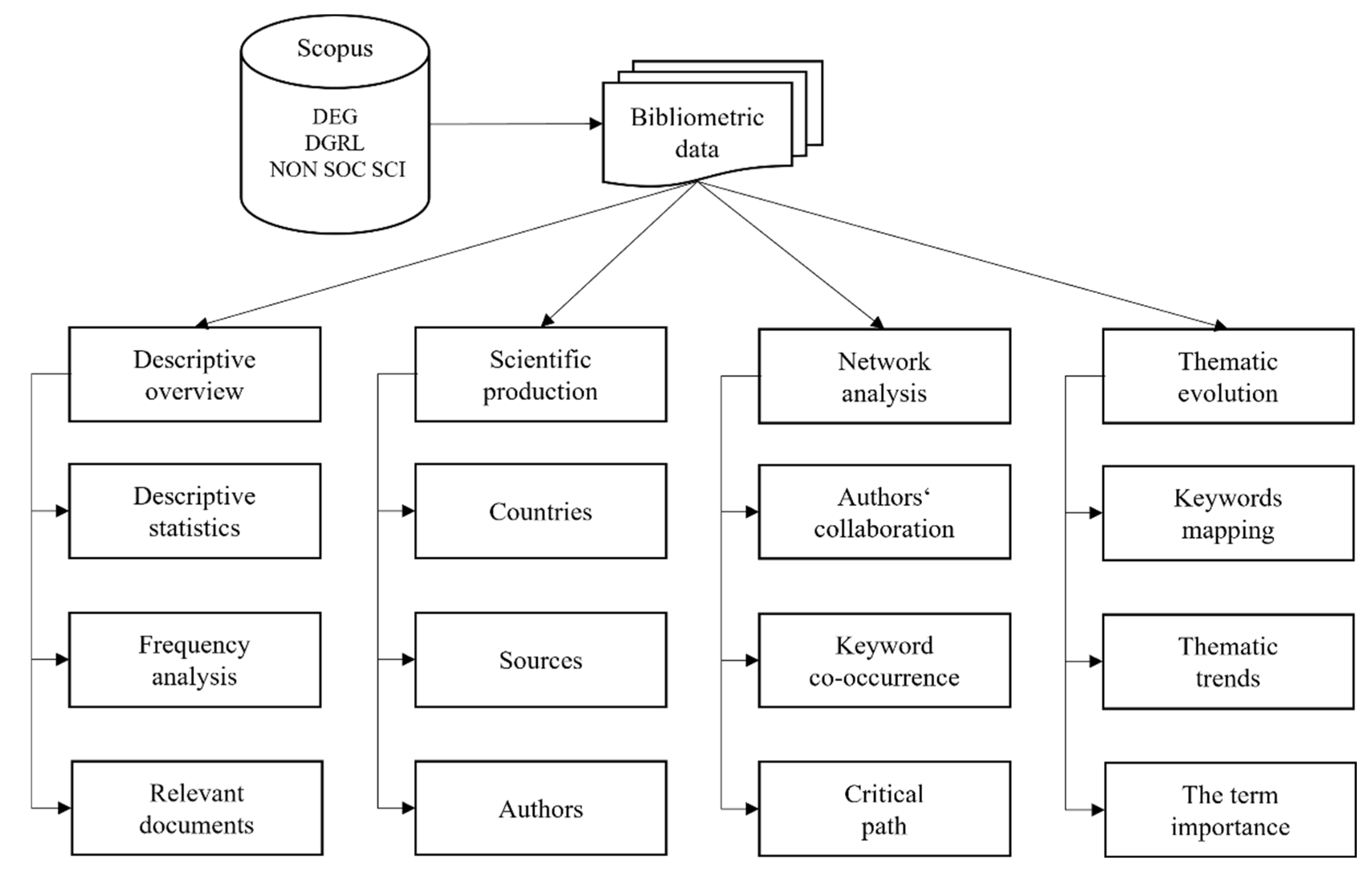
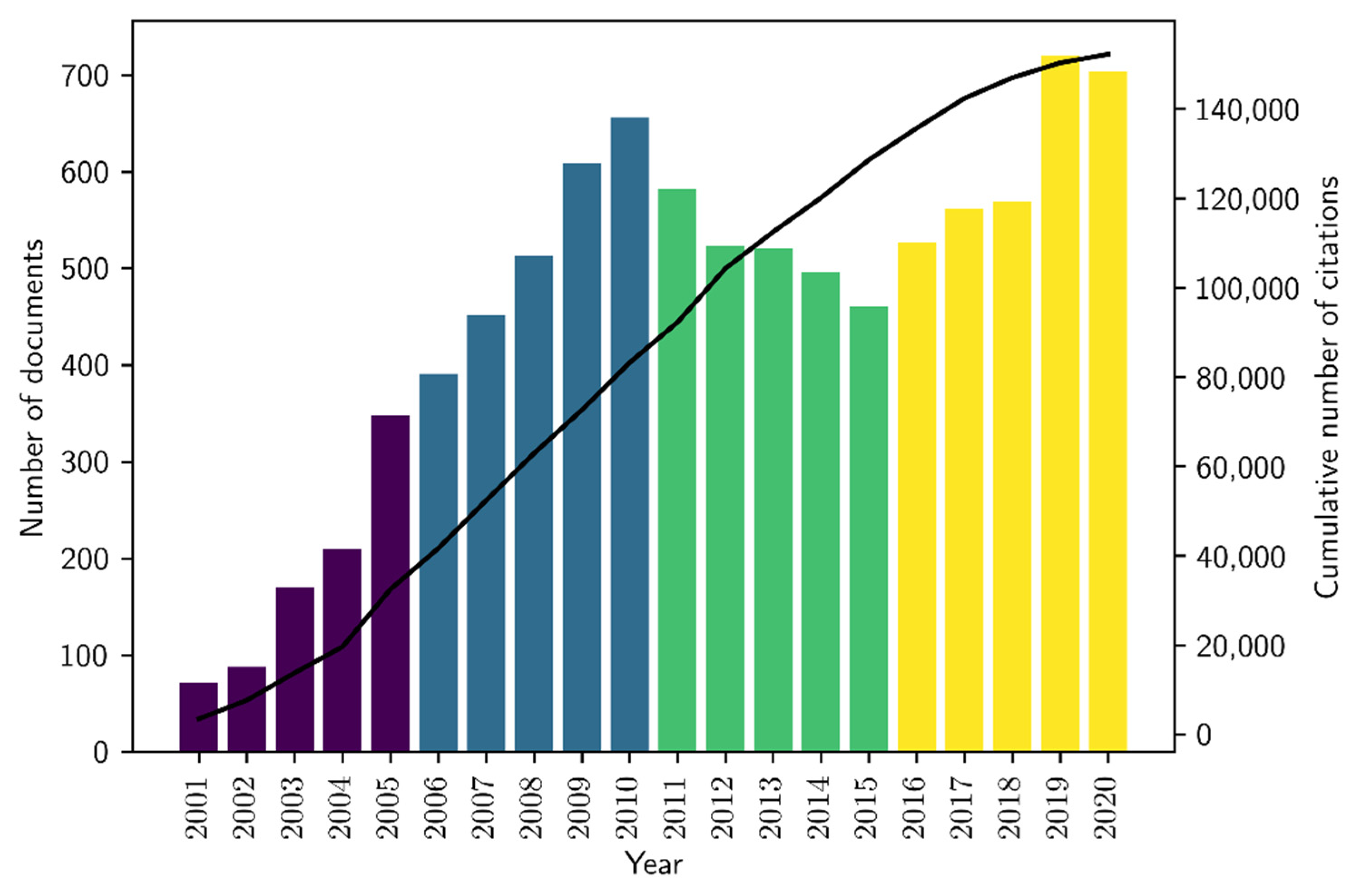

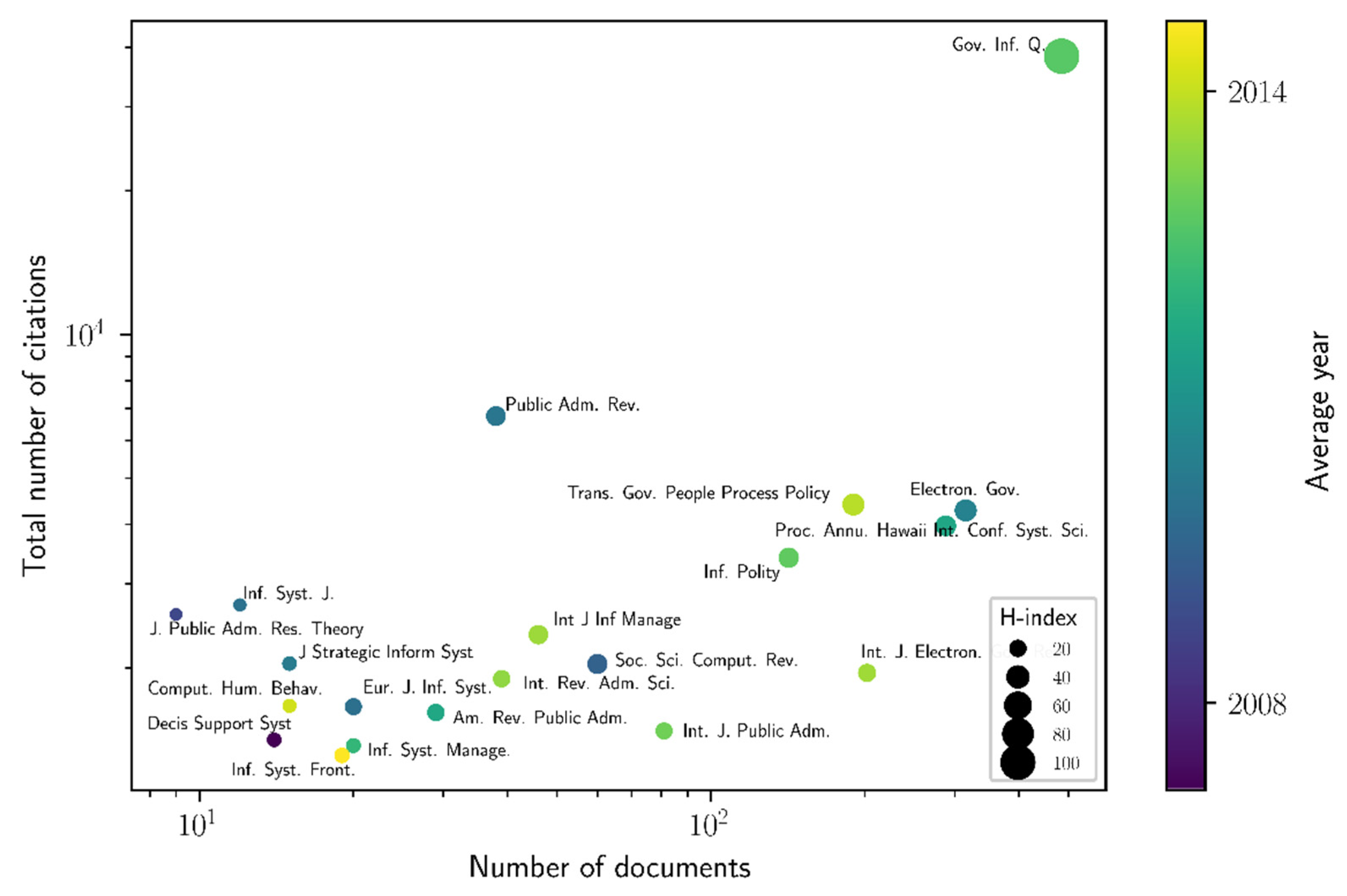
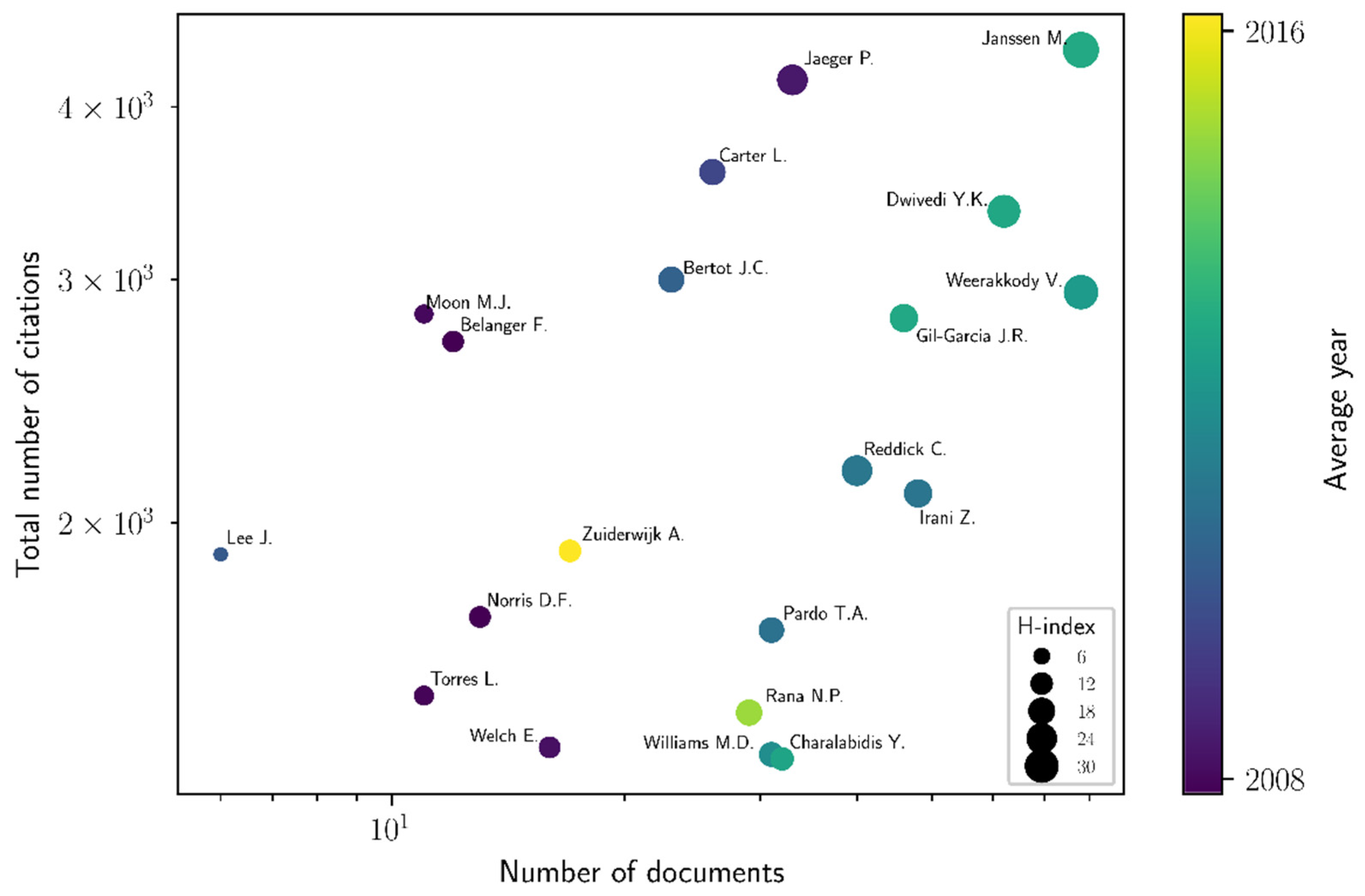
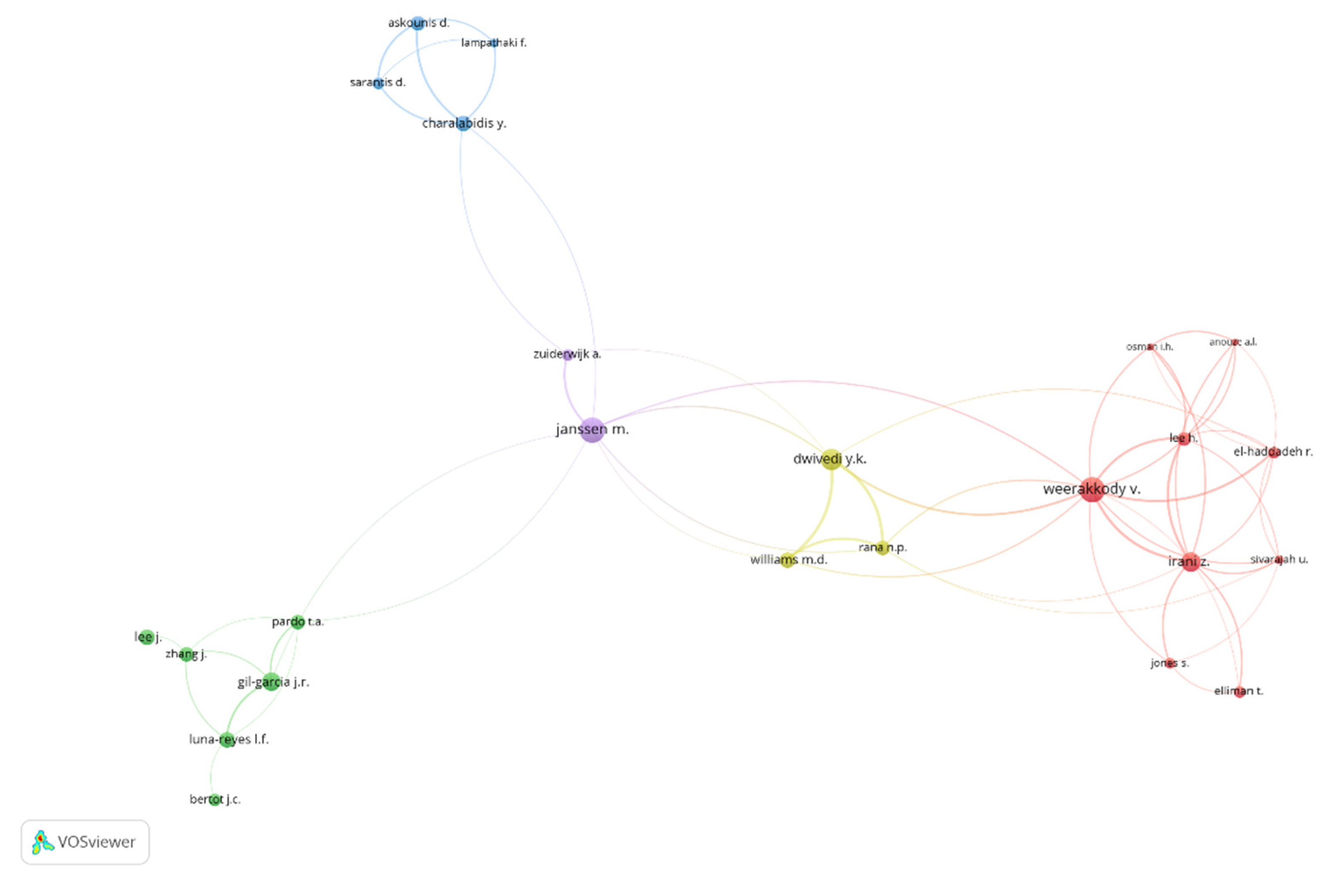
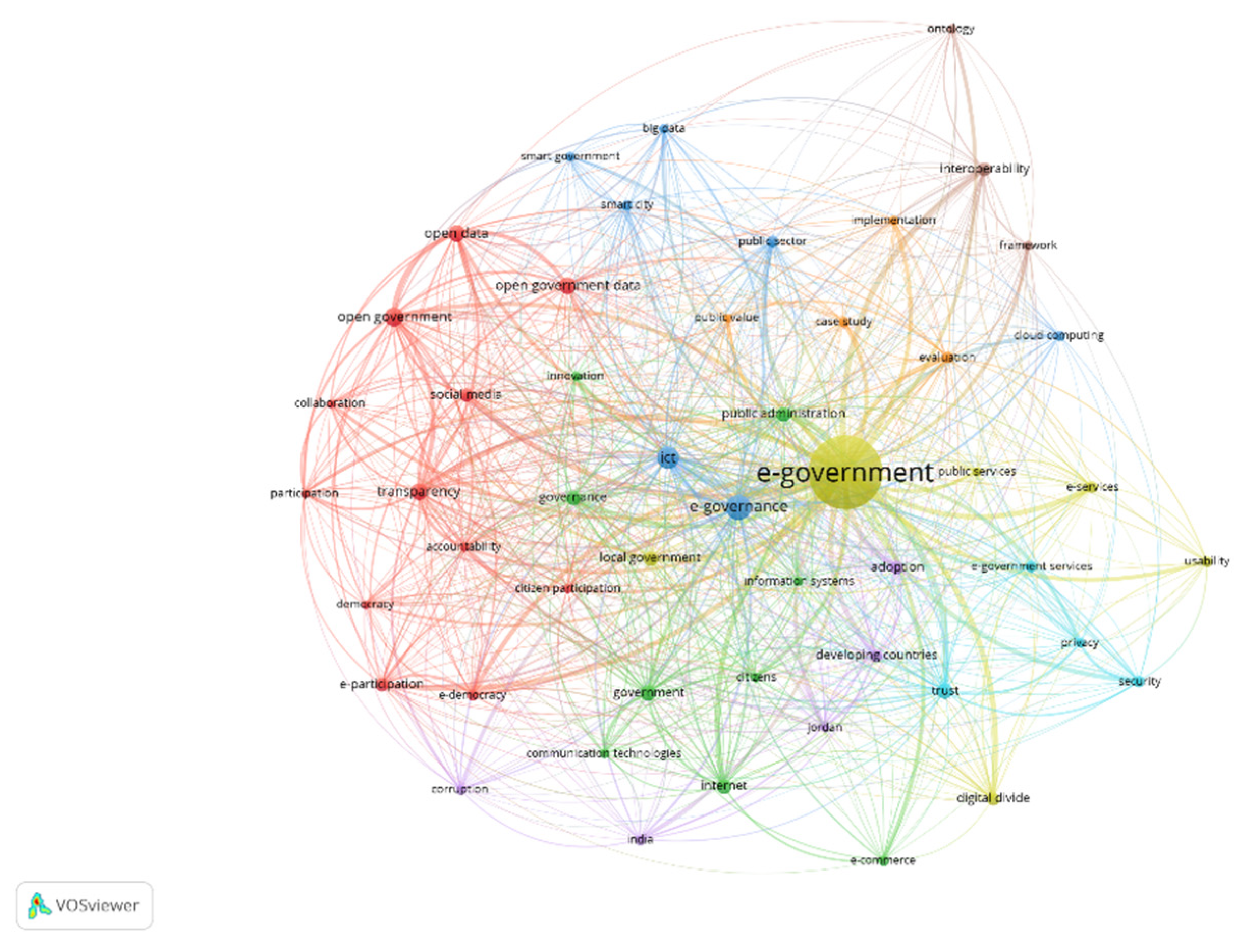
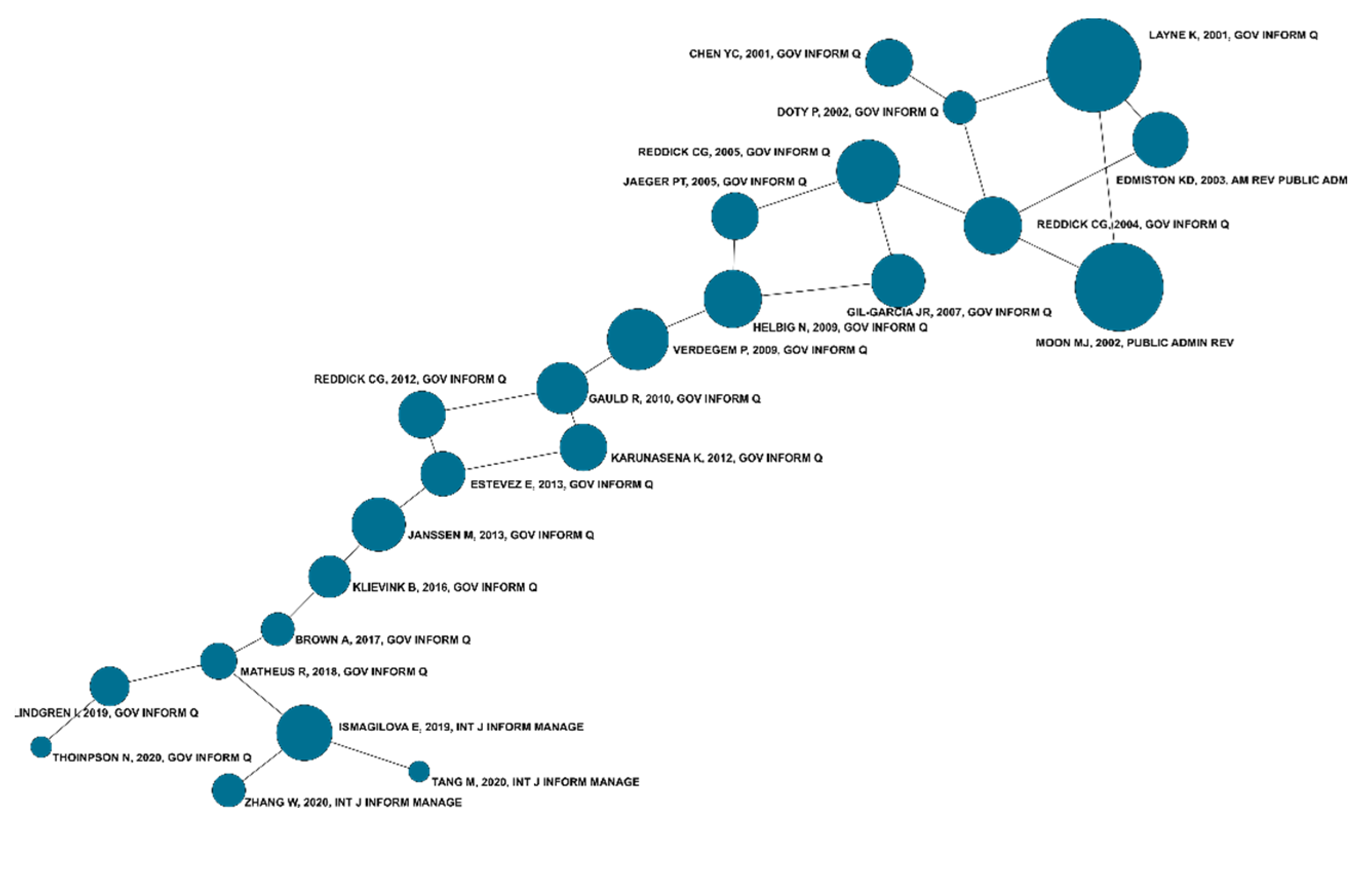
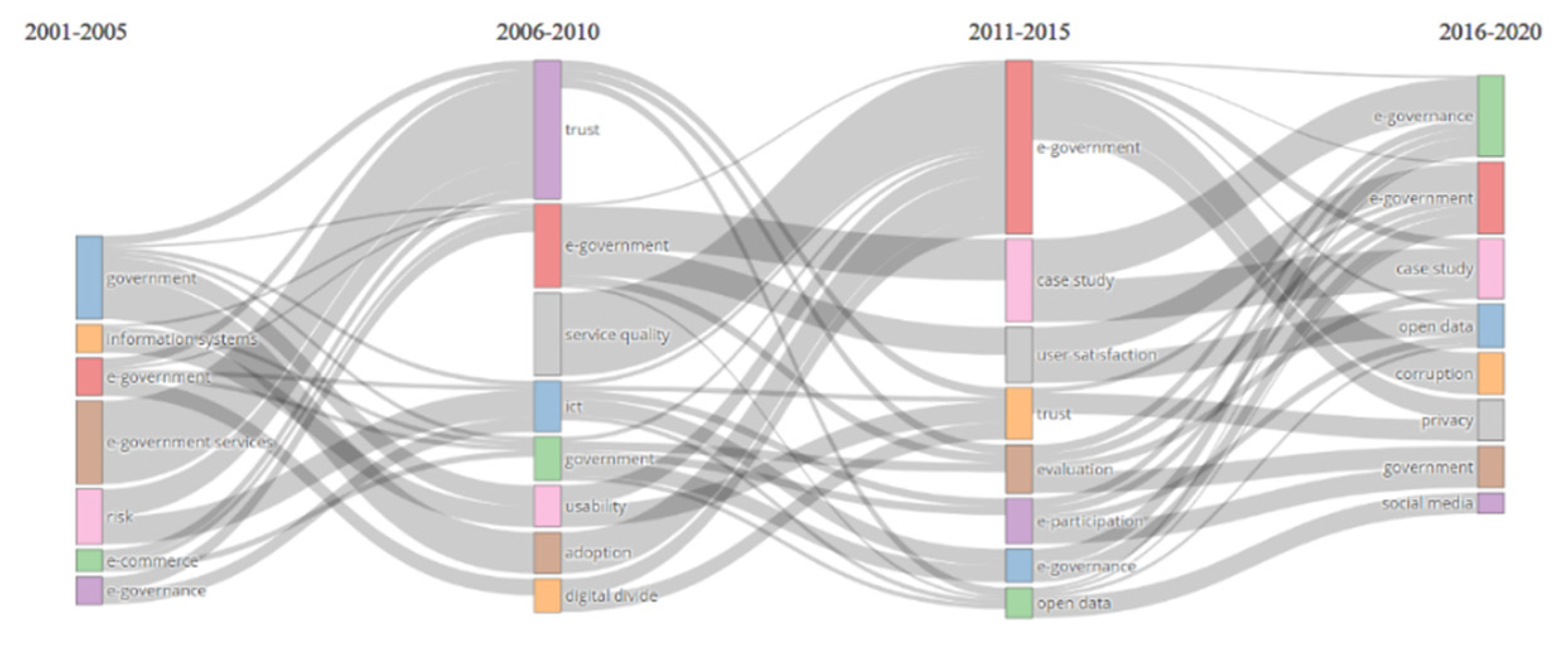

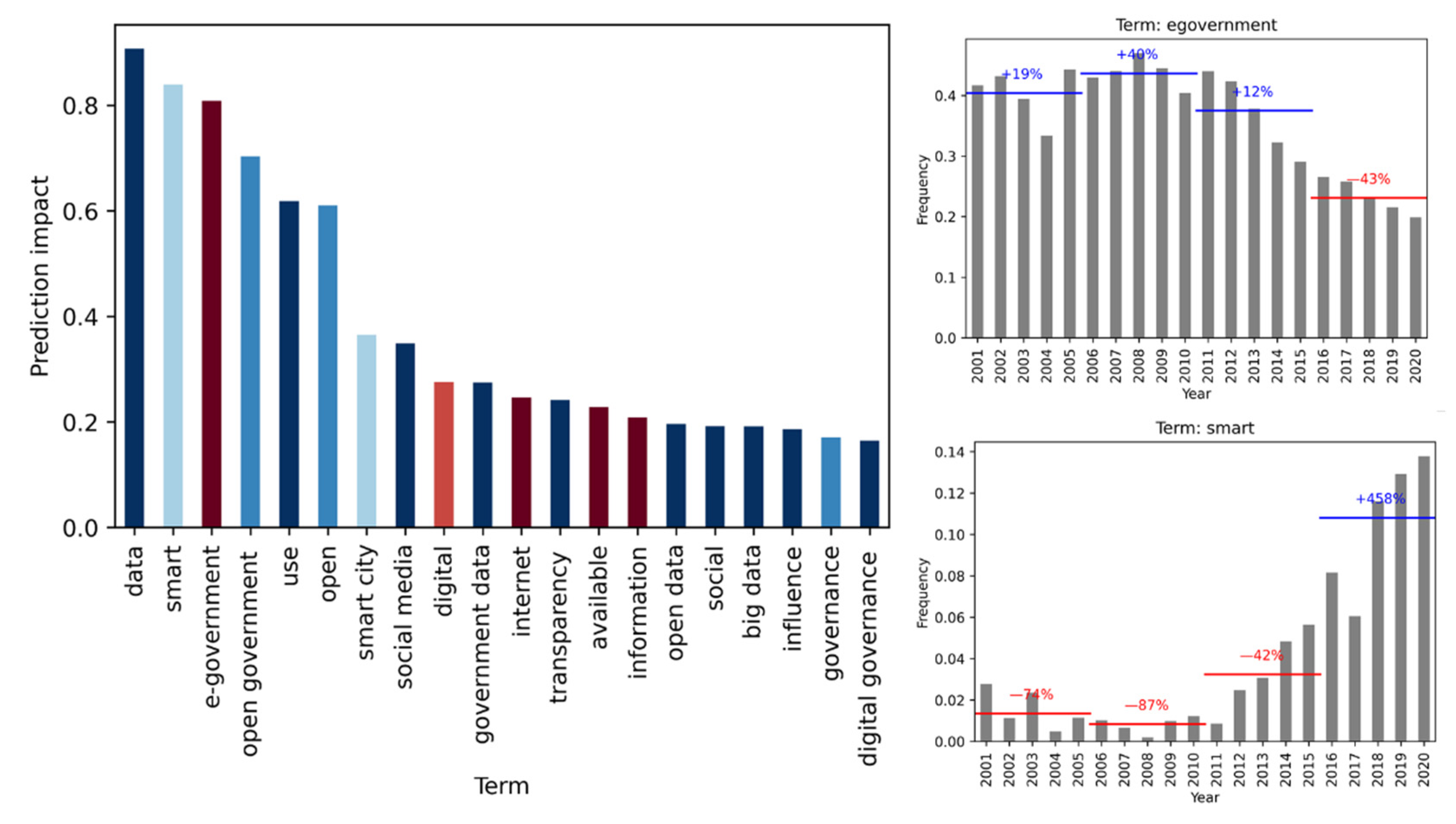
| Bibliometric Items | Findings |
|---|---|
| Timespan | 2001–2020 |
| Documents | 9175 |
| Documents with at least one citation | 7155 |
| Single-authored documents | 2180 |
| Distinct authors | 14,493 |
| Sources (journals, books, etc.) | 2563 |
| Author’s keywords | 14,417 |
| Authors per document | 2.47 |
| Average references per document | 36.41 |
| Average citations per document | 21.27 |
| Authors | Year | Document Title | Source Title | Cited by | |
|---|---|---|---|---|---|
| Layne K., Lee J. | 2001 | Developing fully functional E-government: A four stage model | Gov. Inf. Q. | 1640 | 2001–2005 |
| Carter L., Bélanger F. | 2005 | The utilization of e-government services: Citizen trust, innovation and acceptance factors | Inf. Syst. J. | 1321 | |
| Moon M.J. | 2002 | The evolution of E-government among municipalities: Rhetoric or reality? | Public Adm. Rev. | 1261 | |
| West D.M. | 2004 | E-Government and the Transformation of Service Delivery and Citizen Attitudes | Public Adm. Rev. | 928 | |
| Ho A.T.-K. | 2002 | Reinventing local governments and the E-government initiative | Public Adm. Rev. | 755 | |
| Bertot J.C., Jaeger P.T., Grimes J.M. | 2010 | Using ICTs to create a culture of transparency: E-government and social media as openness and anti-corruption tools for societies | Gov. Inf. Q. | 1243 | 2006–2010 |
| Dunleavy P., Margetts H., Bastow S., Tinkler J. | 2006 | New public management is dead—Long live digital-era governance | J. Public Adm. Res. Theory | 970 | |
| Bélanger F., Carter L. | 2008 | Trust and risk in e-government adoption | J. Strategic Inform. Syst. | 688 | |
| Yildiz M. | 2007 | E-government research: Reviewing the literature, limitations, and ways forward | Gov. Inf. Q. | 647 | |
| Teo T.S.H., Srivastava S.C., Jiang L. | 2008 | Trust and electronic government success: An empirical study | J. Manag. Inf. Syst. | 643 | |
| Janssen M., Charalabidis Y., Zuiderwijk A. | 2012 | Benefits, Adoption Barriers and Myths of Open Data and Open Government | Inf. Syst. Manag. | 940 | 2011–2015 |
| Lu J., Wu D., Mao M., Wang W., Zhang G. | 2015 | Recommender system application developments: A survey | Decis. Support Syst. | 754 | |
| Linders D. | 2012 | From e-government to we-government: Defining a typology for citizen coproduction in the age of social media | Gov. Inf. Q. | 682 | |
| Bonsón E., Torres L., Royo S., Flores F. | 2012 | Local e-government 2.0: Social media and corporate transparency in municipalities | Gov. Inf. Q. | 540 | |
| Bertot J.C., Jaeger P.T., Hansen D. | 2012 | The impact of polices on government social media usage: Issues, challenges, and recommendations | Gov. Inf. Q. | 482 | |
| Meijer A., Bolívar M.P.R. | 2016 | Governing the smart city: a review of the literature on smart urban governance | Int. Rev. Adm. Sci. | 527 | 2016–2020 |
| Dwivedi Y.K., Rana N.P., Janssen M., Lal B., Williams M.D., Clement M. | 2017 | An empirical validation of a unified model of electronic government adoption (UMEGA) | Gov. Inf. Q. | 253 | |
| Janssen M., van der Voort H., Wahyudi A. | 2017 | Factors influencing big data decision-making quality | J. Bus. Res. | 222 | |
| Ismagilova E., Hughes L., Dwivedi Y.K., Raman K.R. | 2019 | Smart cities: Advances in research—An information systems perspective | Int. J. Inf. Manag. | 216 | |
| Arasteh H., Hosseinnezhad V., Loia V., Tommasetti A., Troisi O., Shafie-Khah M., Siano P. | 2016 | IoT-based smart cities: A survey | EEEIC—Int. Conf. Environ. Electr. Eng. | 191 |
Publisher’s Note: MDPI stays neutral with regard to jurisdictional claims in published maps and institutional affiliations. |
© 2022 by the authors. Licensee MDPI, Basel, Switzerland. This article is an open access article distributed under the terms and conditions of the Creative Commons Attribution (CC BY) license (https://creativecommons.org/licenses/by/4.0/).
Share and Cite
Ravšelj, D.; Umek, L.; Todorovski, L.; Aristovnik, A. A Review of Digital Era Governance Research in the First Two Decades: A Bibliometric Study. Future Internet 2022, 14, 126. https://doi.org/10.3390/fi14050126
Ravšelj D, Umek L, Todorovski L, Aristovnik A. A Review of Digital Era Governance Research in the First Two Decades: A Bibliometric Study. Future Internet. 2022; 14(5):126. https://doi.org/10.3390/fi14050126
Chicago/Turabian StyleRavšelj, Dejan, Lan Umek, Ljupčo Todorovski, and Aleksander Aristovnik. 2022. "A Review of Digital Era Governance Research in the First Two Decades: A Bibliometric Study" Future Internet 14, no. 5: 126. https://doi.org/10.3390/fi14050126
APA StyleRavšelj, D., Umek, L., Todorovski, L., & Aristovnik, A. (2022). A Review of Digital Era Governance Research in the First Two Decades: A Bibliometric Study. Future Internet, 14(5), 126. https://doi.org/10.3390/fi14050126







